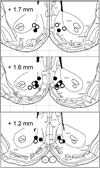Reversible suppression of food reward behavior by chronic mu-opioid receptor antagonism in the nucleus accumbens
- PMID: 20654704
- PMCID: PMC2933316
- DOI: 10.1016/j.neuroscience.2010.07.017
Reversible suppression of food reward behavior by chronic mu-opioid receptor antagonism in the nucleus accumbens
Abstract
Overindulgence in easily available energy-dense palatable foods is thought to be an important factor in the current obesity epidemic but the underlying neural mechanisms are not well understood. Here we demonstrate that mu-opioid receptor signaling in the nucleus accumbens may be important. Protracted suppression of endogenous mu-opioid receptor signaling focused on the nucleus accumbens shell for several days by means of microinjected beta-funaltrexamine (BFNA) diminished both "liking" of sucrose, as indicated by fewer positive hedonic orofacial responses, and the incentive reinforcement value ("wanting") of a food reward, as indicated by lower completion speed and increased time being distracted in the incentive runway. BFNA-treatment also decreased responding to sucrose and corn oil in the brief access lick paradigm, a test measuring a combination of mainly taste-guided "liking" and low-effort "wanting", as well as 4 h intake of sucrose solution. These effects were not due to nonspecific permanent neuronal changes, as they were fully reversible. We conclude that endogenous mu-opioid signaling in the nucleus accumbens is necessary for the full display of palatable food-induced hyperphagia through mechanisms including hedonic, motivational, and reinforcement processes. Development of obesity could be the result of predisposing innate differences in these mechanisms or overstimulation of these mechanisms by external factors.
Keywords: hedonic value; obesity; reward; taste reactivity; ventral striatum; working for food.
Copyright © 2010 IBRO. Published by Elsevier Ltd. All rights reserved.
Figures






Similar articles
-
Chronic suppression of μ-opioid receptor signaling in the nucleus accumbens attenuates development of diet-induced obesity in rats.Int J Obes (Lond). 2010 Jun;34(6):1001-10. doi: 10.1038/ijo.2009.297. Epub 2010 Jan 12. Int J Obes (Lond). 2010. PMID: 20065959 Free PMC article.
-
Mu opioid receptor antagonism in the nucleus accumbens shell blocks consumption of a preferred sucrose solution in an anticipatory contrast paradigm.Neuroscience. 2014 Mar 7;261:144-52. doi: 10.1016/j.neuroscience.2013.12.004. Epub 2013 Dec 14. Neuroscience. 2014. PMID: 24342569 Free PMC article.
-
Hedonic hot spot in nucleus accumbens shell: where do mu-opioids cause increased hedonic impact of sweetness?J Neurosci. 2005 Dec 14;25(50):11777-86. doi: 10.1523/JNEUROSCI.2329-05.2005. J Neurosci. 2005. PMID: 16354936 Free PMC article.
-
Opioid reward 'liking' and 'wanting' in the nucleus accumbens.Physiol Behav. 2008 Aug 6;94(5):675-80. doi: 10.1016/j.physbeh.2008.04.006. Epub 2008 Apr 13. Physiol Behav. 2008. PMID: 18513761 Review.
-
Hedonic and motivational roles of opioids in food reward: implications for overeating disorders.Pharmacol Biochem Behav. 2010 Nov;97(1):34-46. doi: 10.1016/j.pbb.2010.05.016. Epub 2010 May 24. Pharmacol Biochem Behav. 2010. PMID: 20580734 Review.
Cited by
-
Hippocampal leptin signaling reduces food intake and modulates food-related memory processing.Neuropsychopharmacology. 2011 Aug;36(9):1859-70. doi: 10.1038/npp.2011.70. Epub 2011 May 4. Neuropsychopharmacology. 2011. PMID: 21544068 Free PMC article.
-
Endogenous opioids in the nucleus accumbens promote approach to high-fat food in the absence of caloric need.Elife. 2018 Mar 27;7:e34955. doi: 10.7554/eLife.34955. Elife. 2018. PMID: 29582754 Free PMC article.
-
Effect of diet on preference and intake of sucrose in obese prone and resistant rats.PLoS One. 2014 Oct 20;9(10):e111232. doi: 10.1371/journal.pone.0111232. eCollection 2014. PLoS One. 2014. PMID: 25329959 Free PMC article.
-
Metabolic vs. hedonic obesity: a conceptual distinction and its clinical implications.Obes Rev. 2015 Mar;16(3):234-47. doi: 10.1111/obr.12246. Epub 2015 Jan 14. Obes Rev. 2015. PMID: 25588316 Free PMC article. Review.
-
Finding the balance between model complexity and performance: Using ventral striatal oscillations to classify feeding behavior in rats.PLoS Comput Biol. 2019 Apr 22;15(4):e1006838. doi: 10.1371/journal.pcbi.1006838. eCollection 2019 Apr. PLoS Comput Biol. 2019. PMID: 31009448 Free PMC article.
References
-
- Arjune D, Standifer KM, Pasternak GW, Bodnar RJ. Reduction by central beta-funaltrexamine of food intake in rats under freely-feeding, deprivation and glucoprivic conditions. Brain Res. 1990;535:101–109. - PubMed
-
- Berridge KC. Food reward: brain substrates of wanting and liking. Neurosci Biobehav Rev. 1996;20:1–25. - PubMed
-
- Berridge KC. Measuring hedonic impact in animals and infants: microstructure of affective taste reactivity patterns. Neurosci Biobehav Rev. 2000;24:173–198. - PubMed
-
- Berridge KC. The debate over dopamine's role in reward: the case for incentive salience. Psychopharmacology (Berl) 2007;191:391–431. - PubMed
Publication types
MeSH terms
Substances
Grants and funding
LinkOut - more resources
Full Text Sources
Research Materials

